PJMN004W Project Finance: Risk Evaluation in Argentina Power Case
VerifiedAdded on 2023/06/15
|9
|2243
|408
Case Study
AI Summary
This case study delves into the complexities of project finance and procurement within Argentina's power sector, focusing on the "Argentina Power – Don’t Cry for Me Argentina" case. It identifies and discusses various risks associated with such projects, including political, financial, enforcement, project execution, operational, and currency risks. The study also explores mitigation strategies employed by different administrations and the role of key agreements like PPAs and EPC contracts in managing these risks. Furthermore, it evaluates the reasons why the EFC committee should or should not invest in the project, considering factors such as IRR estimations, loan terms, and potential governmental purchase settlement failures. The analysis concludes that while Argentina's electricity sector presents challenges, strategic international collaborations and well-structured agreements are crucial for its revival, emphasizing the need for integrity and protection of stakeholder interests.

Project Finance and
Procurement
Procurement
Paraphrase This Document
Need a fresh take? Get an instant paraphrase of this document with our AI Paraphraser

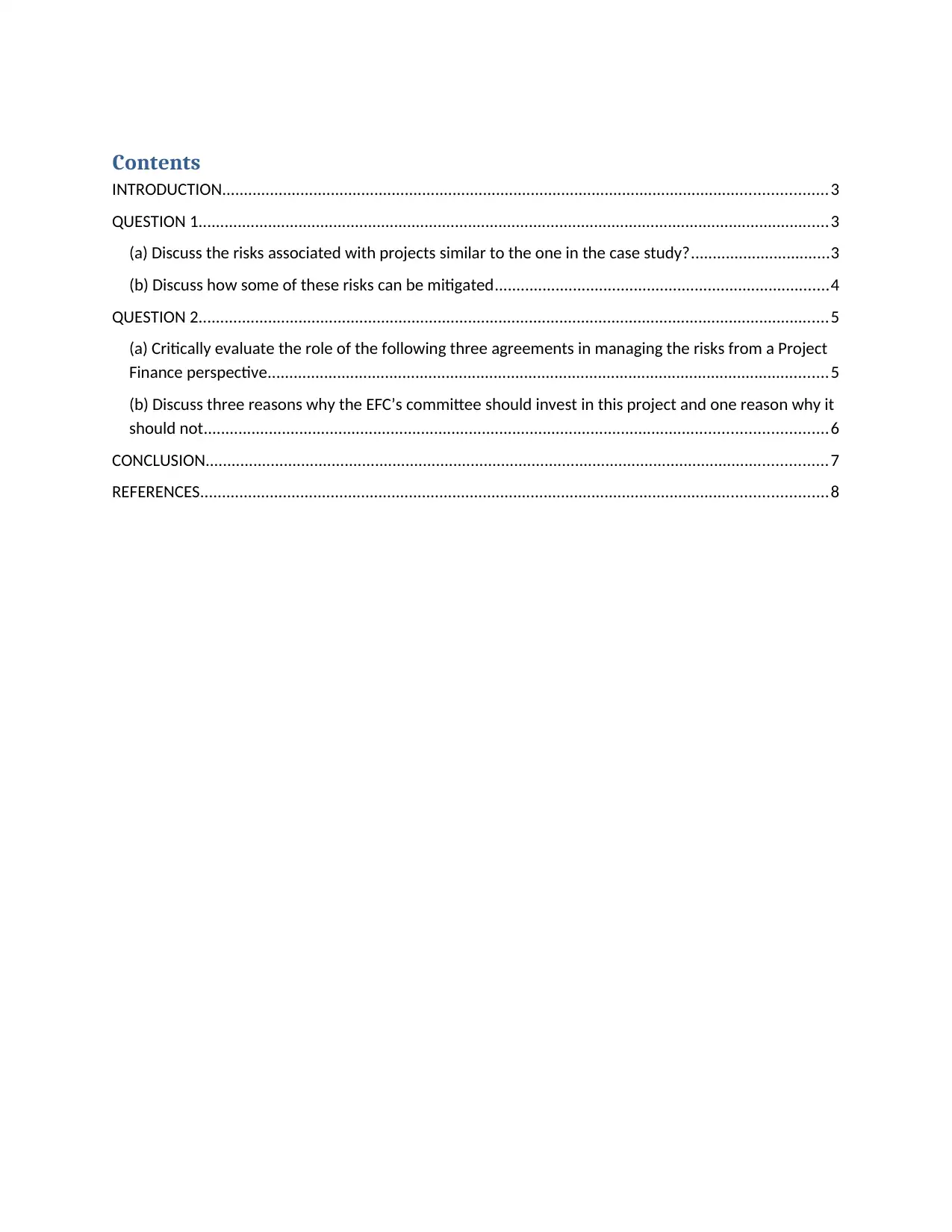
Contents
INTRODUCTION...........................................................................................................................................3
QUESTION 1.................................................................................................................................................3
(a) Discuss the risks associated with projects similar to the one in the case study?................................3
(b) Discuss how some of these risks can be mitigated.............................................................................4
QUESTION 2.................................................................................................................................................5
(a) Critically evaluate the role of the following three agreements in managing the risks from a Project
Finance perspective.................................................................................................................................5
(b) Discuss three reasons why the EFC’s committee should invest in this project and one reason why it
should not...............................................................................................................................................6
CONCLUSION...............................................................................................................................................7
REFERENCES................................................................................................................................................8
INTRODUCTION...........................................................................................................................................3
QUESTION 1.................................................................................................................................................3
(a) Discuss the risks associated with projects similar to the one in the case study?................................3
(b) Discuss how some of these risks can be mitigated.............................................................................4
QUESTION 2.................................................................................................................................................5
(a) Critically evaluate the role of the following three agreements in managing the risks from a Project
Finance perspective.................................................................................................................................5
(b) Discuss three reasons why the EFC’s committee should invest in this project and one reason why it
should not...............................................................................................................................................6
CONCLUSION...............................................................................................................................................7
REFERENCES................................................................................................................................................8
⊘ This is a preview!⊘
Do you want full access?
Subscribe today to unlock all pages.

Trusted by 1+ million students worldwide
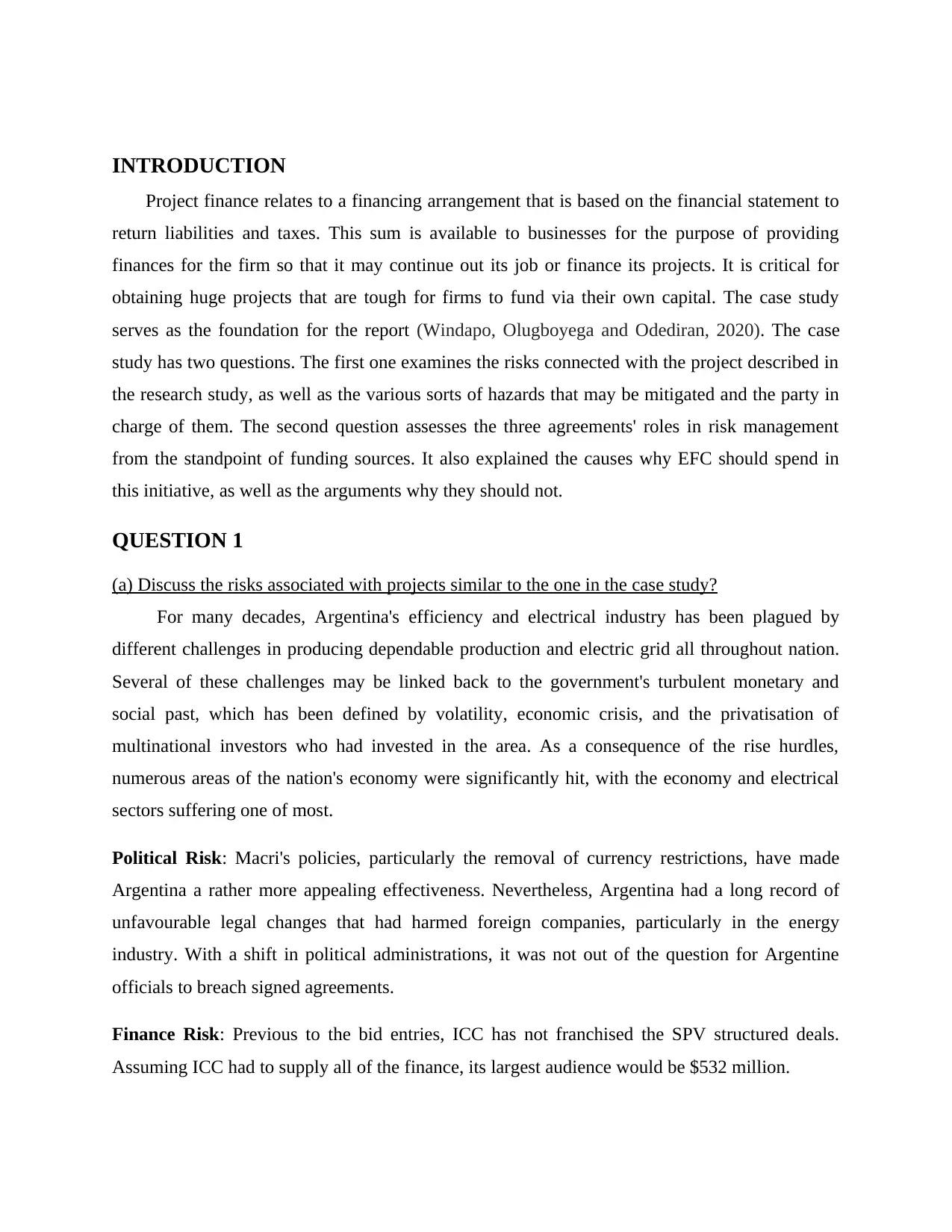
INTRODUCTION
Project finance relates to a financing arrangement that is based on the financial statement to
return liabilities and taxes. This sum is available to businesses for the purpose of providing
finances for the firm so that it may continue out its job or finance its projects. It is critical for
obtaining huge projects that are tough for firms to fund via their own capital. The case study
serves as the foundation for the report (Windapo, Olugboyega and Odediran, 2020). The case
study has two questions. The first one examines the risks connected with the project described in
the research study, as well as the various sorts of hazards that may be mitigated and the party in
charge of them. The second question assesses the three agreements' roles in risk management
from the standpoint of funding sources. It also explained the causes why EFC should spend in
this initiative, as well as the arguments why they should not.
QUESTION 1
(a) Discuss the risks associated with projects similar to the one in the case study?
For many decades, Argentina's efficiency and electrical industry has been plagued by
different challenges in producing dependable production and electric grid all throughout nation.
Several of these challenges may be linked back to the government's turbulent monetary and
social past, which has been defined by volatility, economic crisis, and the privatisation of
multinational investors who had invested in the area. As a consequence of the rise hurdles,
numerous areas of the nation's economy were significantly hit, with the economy and electrical
sectors suffering one of most.
Political Risk: Macri's policies, particularly the removal of currency restrictions, have made
Argentina a rather more appealing effectiveness. Nevertheless, Argentina had a long record of
unfavourable legal changes that had harmed foreign companies, particularly in the energy
industry. With a shift in political administrations, it was not out of the question for Argentine
officials to breach signed agreements.
Finance Risk: Previous to the bid entries, ICC has not franchised the SPV structured deals.
Assuming ICC had to supply all of the finance, its largest audience would be $532 million.
Project finance relates to a financing arrangement that is based on the financial statement to
return liabilities and taxes. This sum is available to businesses for the purpose of providing
finances for the firm so that it may continue out its job or finance its projects. It is critical for
obtaining huge projects that are tough for firms to fund via their own capital. The case study
serves as the foundation for the report (Windapo, Olugboyega and Odediran, 2020). The case
study has two questions. The first one examines the risks connected with the project described in
the research study, as well as the various sorts of hazards that may be mitigated and the party in
charge of them. The second question assesses the three agreements' roles in risk management
from the standpoint of funding sources. It also explained the causes why EFC should spend in
this initiative, as well as the arguments why they should not.
QUESTION 1
(a) Discuss the risks associated with projects similar to the one in the case study?
For many decades, Argentina's efficiency and electrical industry has been plagued by
different challenges in producing dependable production and electric grid all throughout nation.
Several of these challenges may be linked back to the government's turbulent monetary and
social past, which has been defined by volatility, economic crisis, and the privatisation of
multinational investors who had invested in the area. As a consequence of the rise hurdles,
numerous areas of the nation's economy were significantly hit, with the economy and electrical
sectors suffering one of most.
Political Risk: Macri's policies, particularly the removal of currency restrictions, have made
Argentina a rather more appealing effectiveness. Nevertheless, Argentina had a long record of
unfavourable legal changes that had harmed foreign companies, particularly in the energy
industry. With a shift in political administrations, it was not out of the question for Argentine
officials to breach signed agreements.
Finance Risk: Previous to the bid entries, ICC has not franchised the SPV structured deals.
Assuming ICC had to supply all of the finance, its largest audience would be $532 million.
Paraphrase This Document
Need a fresh take? Get an instant paraphrase of this document with our AI Paraphraser
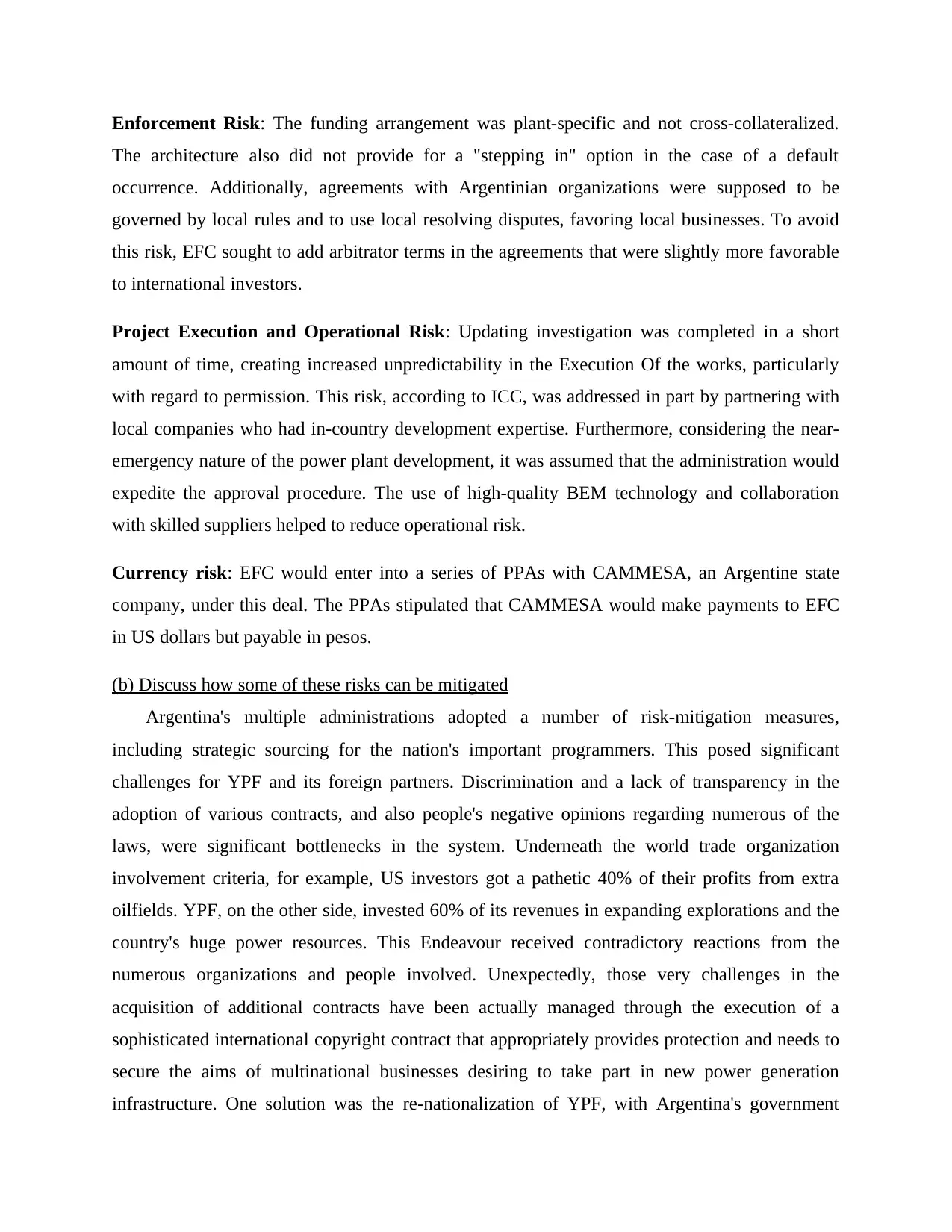
Enforcement Risk: The funding arrangement was plant-specific and not cross-collateralized.
The architecture also did not provide for a "stepping in" option in the case of a default
occurrence. Additionally, agreements with Argentinian organizations were supposed to be
governed by local rules and to use local resolving disputes, favoring local businesses. To avoid
this risk, EFC sought to add arbitrator terms in the agreements that were slightly more favorable
to international investors.
Project Execution and Operational Risk: Updating investigation was completed in a short
amount of time, creating increased unpredictability in the Execution Of the works, particularly
with regard to permission. This risk, according to ICC, was addressed in part by partnering with
local companies who had in-country development expertise. Furthermore, considering the near-
emergency nature of the power plant development, it was assumed that the administration would
expedite the approval procedure. The use of high-quality BEM technology and collaboration
with skilled suppliers helped to reduce operational risk.
Currency risk: EFC would enter into a series of PPAs with CAMMESA, an Argentine state
company, under this deal. The PPAs stipulated that CAMMESA would make payments to EFC
in US dollars but payable in pesos.
(b) Discuss how some of these risks can be mitigated
Argentina's multiple administrations adopted a number of risk-mitigation measures,
including strategic sourcing for the nation's important programmers. This posed significant
challenges for YPF and its foreign partners. Discrimination and a lack of transparency in the
adoption of various contracts, and also people's negative opinions regarding numerous of the
laws, were significant bottlenecks in the system. Underneath the world trade organization
involvement criteria, for example, US investors got a pathetic 40% of their profits from extra
oilfields. YPF, on the other side, invested 60% of its revenues in expanding explorations and the
country's huge power resources. This Endeavour received contradictory reactions from the
numerous organizations and people involved. Unexpectedly, those very challenges in the
acquisition of additional contracts have been actually managed through the execution of a
sophisticated international copyright contract that appropriately provides protection and needs to
secure the aims of multinational businesses desiring to take part in new power generation
infrastructure. One solution was the re-nationalization of YPF, with Argentina's government
The architecture also did not provide for a "stepping in" option in the case of a default
occurrence. Additionally, agreements with Argentinian organizations were supposed to be
governed by local rules and to use local resolving disputes, favoring local businesses. To avoid
this risk, EFC sought to add arbitrator terms in the agreements that were slightly more favorable
to international investors.
Project Execution and Operational Risk: Updating investigation was completed in a short
amount of time, creating increased unpredictability in the Execution Of the works, particularly
with regard to permission. This risk, according to ICC, was addressed in part by partnering with
local companies who had in-country development expertise. Furthermore, considering the near-
emergency nature of the power plant development, it was assumed that the administration would
expedite the approval procedure. The use of high-quality BEM technology and collaboration
with skilled suppliers helped to reduce operational risk.
Currency risk: EFC would enter into a series of PPAs with CAMMESA, an Argentine state
company, under this deal. The PPAs stipulated that CAMMESA would make payments to EFC
in US dollars but payable in pesos.
(b) Discuss how some of these risks can be mitigated
Argentina's multiple administrations adopted a number of risk-mitigation measures,
including strategic sourcing for the nation's important programmers. This posed significant
challenges for YPF and its foreign partners. Discrimination and a lack of transparency in the
adoption of various contracts, and also people's negative opinions regarding numerous of the
laws, were significant bottlenecks in the system. Underneath the world trade organization
involvement criteria, for example, US investors got a pathetic 40% of their profits from extra
oilfields. YPF, on the other side, invested 60% of its revenues in expanding explorations and the
country's huge power resources. This Endeavour received contradictory reactions from the
numerous organizations and people involved. Unexpectedly, those very challenges in the
acquisition of additional contracts have been actually managed through the execution of a
sophisticated international copyright contract that appropriately provides protection and needs to
secure the aims of multinational businesses desiring to take part in new power generation
infrastructure. One solution was the re-nationalization of YPF, with Argentina's government
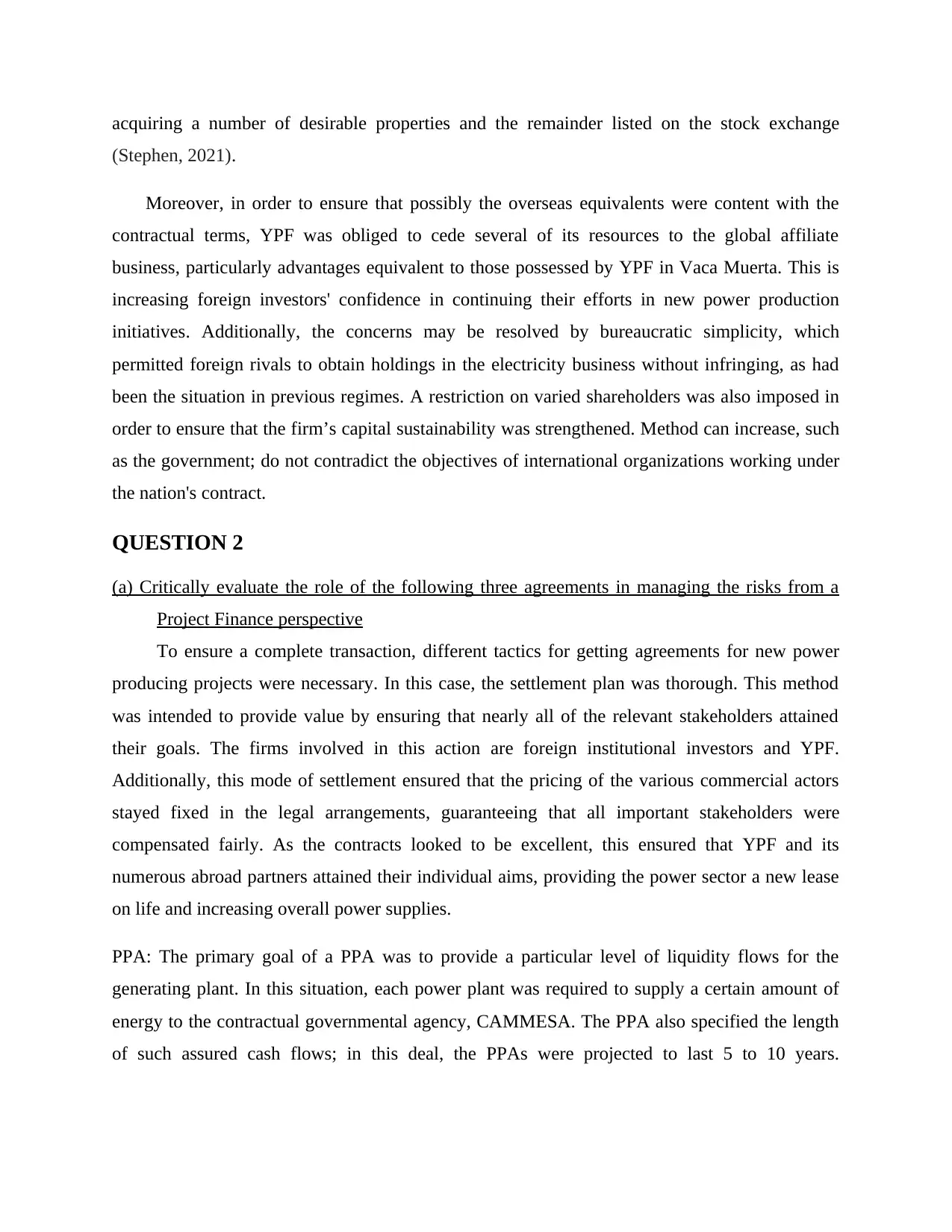
acquiring a number of desirable properties and the remainder listed on the stock exchange
(Stephen, 2021).
Moreover, in order to ensure that possibly the overseas equivalents were content with the
contractual terms, YPF was obliged to cede several of its resources to the global affiliate
business, particularly advantages equivalent to those possessed by YPF in Vaca Muerta. This is
increasing foreign investors' confidence in continuing their efforts in new power production
initiatives. Additionally, the concerns may be resolved by bureaucratic simplicity, which
permitted foreign rivals to obtain holdings in the electricity business without infringing, as had
been the situation in previous regimes. A restriction on varied shareholders was also imposed in
order to ensure that the firm’s capital sustainability was strengthened. Method can increase, such
as the government; do not contradict the objectives of international organizations working under
the nation's contract.
QUESTION 2
(a) Critically evaluate the role of the following three agreements in managing the risks from a
Project Finance perspective
To ensure a complete transaction, different tactics for getting agreements for new power
producing projects were necessary. In this case, the settlement plan was thorough. This method
was intended to provide value by ensuring that nearly all of the relevant stakeholders attained
their goals. The firms involved in this action are foreign institutional investors and YPF.
Additionally, this mode of settlement ensured that the pricing of the various commercial actors
stayed fixed in the legal arrangements, guaranteeing that all important stakeholders were
compensated fairly. As the contracts looked to be excellent, this ensured that YPF and its
numerous abroad partners attained their individual aims, providing the power sector a new lease
on life and increasing overall power supplies.
PPA: The primary goal of a PPA was to provide a particular level of liquidity flows for the
generating plant. In this situation, each power plant was required to supply a certain amount of
energy to the contractual governmental agency, CAMMESA. The PPA also specified the length
of such assured cash flows; in this deal, the PPAs were projected to last 5 to 10 years.
(Stephen, 2021).
Moreover, in order to ensure that possibly the overseas equivalents were content with the
contractual terms, YPF was obliged to cede several of its resources to the global affiliate
business, particularly advantages equivalent to those possessed by YPF in Vaca Muerta. This is
increasing foreign investors' confidence in continuing their efforts in new power production
initiatives. Additionally, the concerns may be resolved by bureaucratic simplicity, which
permitted foreign rivals to obtain holdings in the electricity business without infringing, as had
been the situation in previous regimes. A restriction on varied shareholders was also imposed in
order to ensure that the firm’s capital sustainability was strengthened. Method can increase, such
as the government; do not contradict the objectives of international organizations working under
the nation's contract.
QUESTION 2
(a) Critically evaluate the role of the following three agreements in managing the risks from a
Project Finance perspective
To ensure a complete transaction, different tactics for getting agreements for new power
producing projects were necessary. In this case, the settlement plan was thorough. This method
was intended to provide value by ensuring that nearly all of the relevant stakeholders attained
their goals. The firms involved in this action are foreign institutional investors and YPF.
Additionally, this mode of settlement ensured that the pricing of the various commercial actors
stayed fixed in the legal arrangements, guaranteeing that all important stakeholders were
compensated fairly. As the contracts looked to be excellent, this ensured that YPF and its
numerous abroad partners attained their individual aims, providing the power sector a new lease
on life and increasing overall power supplies.
PPA: The primary goal of a PPA was to provide a particular level of liquidity flows for the
generating plant. In this situation, each power plant was required to supply a certain amount of
energy to the contractual governmental agency, CAMMESA. The PPA also specified the length
of such assured cash flows; in this deal, the PPAs were projected to last 5 to 10 years.
⊘ This is a preview!⊘
Do you want full access?
Subscribe today to unlock all pages.

Trusted by 1+ million students worldwide
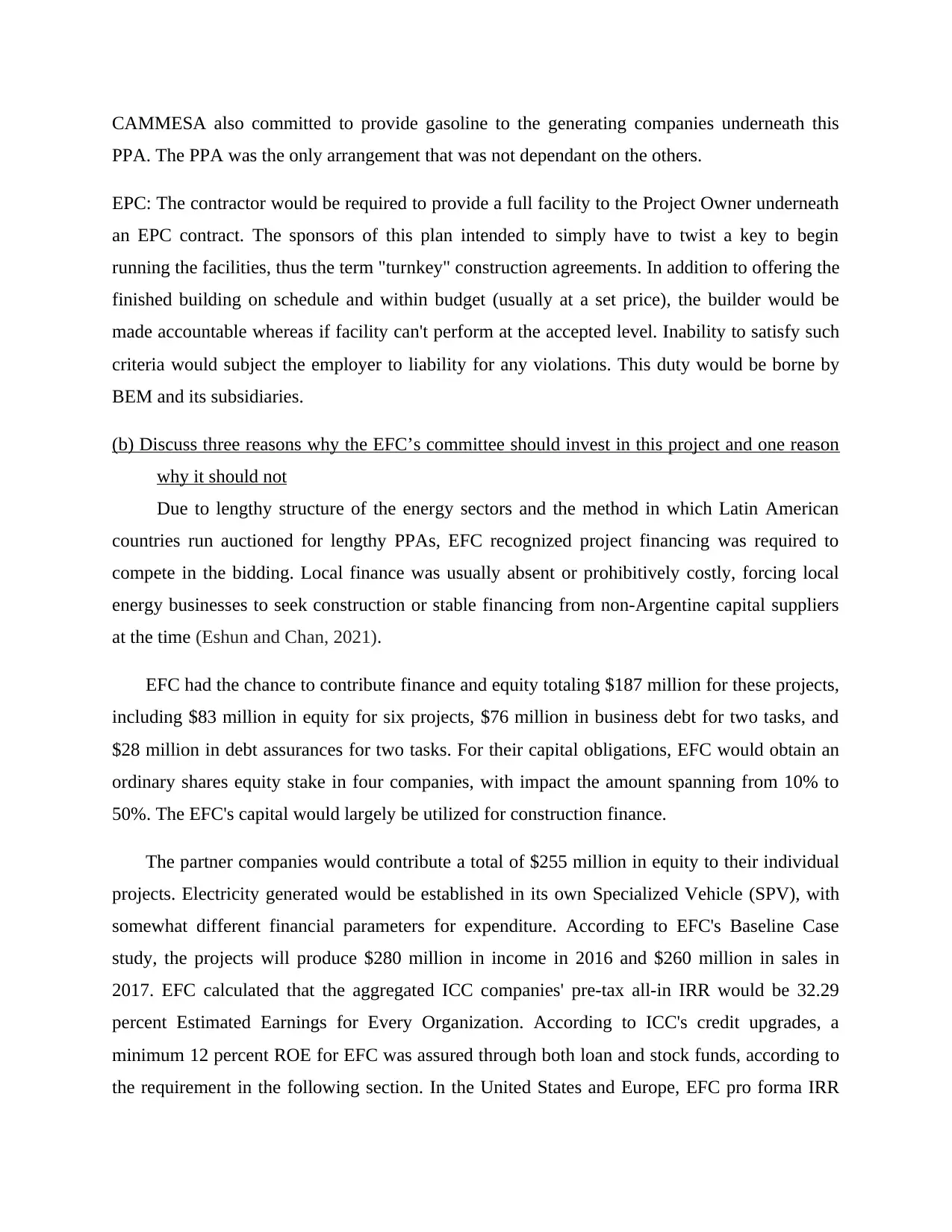
CAMMESA also committed to provide gasoline to the generating companies underneath this
PPA. The PPA was the only arrangement that was not dependant on the others.
EPC: The contractor would be required to provide a full facility to the Project Owner underneath
an EPC contract. The sponsors of this plan intended to simply have to twist a key to begin
running the facilities, thus the term "turnkey" construction agreements. In addition to offering the
finished building on schedule and within budget (usually at a set price), the builder would be
made accountable whereas if facility can't perform at the accepted level. Inability to satisfy such
criteria would subject the employer to liability for any violations. This duty would be borne by
BEM and its subsidiaries.
(b) Discuss three reasons why the EFC’s committee should invest in this project and one reason
why it should not
Due to lengthy structure of the energy sectors and the method in which Latin American
countries run auctioned for lengthy PPAs, EFC recognized project financing was required to
compete in the bidding. Local finance was usually absent or prohibitively costly, forcing local
energy businesses to seek construction or stable financing from non-Argentine capital suppliers
at the time (Eshun and Chan, 2021).
EFC had the chance to contribute finance and equity totaling $187 million for these projects,
including $83 million in equity for six projects, $76 million in business debt for two tasks, and
$28 million in debt assurances for two tasks. For their capital obligations, EFC would obtain an
ordinary shares equity stake in four companies, with impact the amount spanning from 10% to
50%. The EFC's capital would largely be utilized for construction finance.
The partner companies would contribute a total of $255 million in equity to their individual
projects. Electricity generated would be established in its own Specialized Vehicle (SPV), with
somewhat different financial parameters for expenditure. According to EFC's Baseline Case
study, the projects will produce $280 million in income in 2016 and $260 million in sales in
2017. EFC calculated that the aggregated ICC companies' pre-tax all-in IRR would be 32.29
percent Estimated Earnings for Every Organization. According to ICC's credit upgrades, a
minimum 12 percent ROE for EFC was assured through both loan and stock funds, according to
the requirement in the following section. In the United States and Europe, EFC pro forma IRR
PPA. The PPA was the only arrangement that was not dependant on the others.
EPC: The contractor would be required to provide a full facility to the Project Owner underneath
an EPC contract. The sponsors of this plan intended to simply have to twist a key to begin
running the facilities, thus the term "turnkey" construction agreements. In addition to offering the
finished building on schedule and within budget (usually at a set price), the builder would be
made accountable whereas if facility can't perform at the accepted level. Inability to satisfy such
criteria would subject the employer to liability for any violations. This duty would be borne by
BEM and its subsidiaries.
(b) Discuss three reasons why the EFC’s committee should invest in this project and one reason
why it should not
Due to lengthy structure of the energy sectors and the method in which Latin American
countries run auctioned for lengthy PPAs, EFC recognized project financing was required to
compete in the bidding. Local finance was usually absent or prohibitively costly, forcing local
energy businesses to seek construction or stable financing from non-Argentine capital suppliers
at the time (Eshun and Chan, 2021).
EFC had the chance to contribute finance and equity totaling $187 million for these projects,
including $83 million in equity for six projects, $76 million in business debt for two tasks, and
$28 million in debt assurances for two tasks. For their capital obligations, EFC would obtain an
ordinary shares equity stake in four companies, with impact the amount spanning from 10% to
50%. The EFC's capital would largely be utilized for construction finance.
The partner companies would contribute a total of $255 million in equity to their individual
projects. Electricity generated would be established in its own Specialized Vehicle (SPV), with
somewhat different financial parameters for expenditure. According to EFC's Baseline Case
study, the projects will produce $280 million in income in 2016 and $260 million in sales in
2017. EFC calculated that the aggregated ICC companies' pre-tax all-in IRR would be 32.29
percent Estimated Earnings for Every Organization. According to ICC's credit upgrades, a
minimum 12 percent ROE for EFC was assured through both loan and stock funds, according to
the requirement in the following section. In the United States and Europe, EFC pro forma IRR
Paraphrase This Document
Need a fresh take? Get an instant paraphrase of this document with our AI Paraphraser
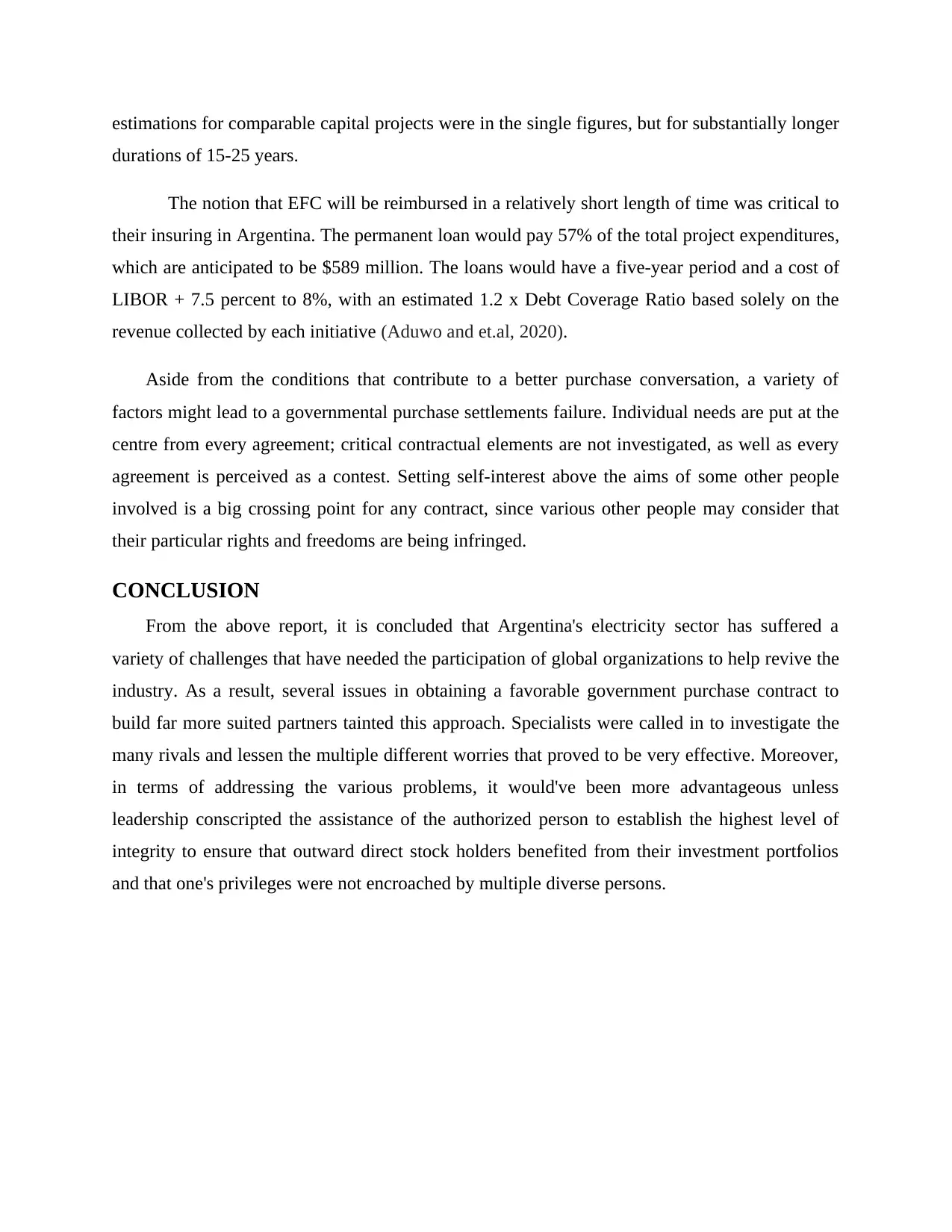
estimations for comparable capital projects were in the single figures, but for substantially longer
durations of 15-25 years.
The notion that EFC will be reimbursed in a relatively short length of time was critical to
their insuring in Argentina. The permanent loan would pay 57% of the total project expenditures,
which are anticipated to be $589 million. The loans would have a five-year period and a cost of
LIBOR + 7.5 percent to 8%, with an estimated 1.2 x Debt Coverage Ratio based solely on the
revenue collected by each initiative (Aduwo and et.al, 2020).
Aside from the conditions that contribute to a better purchase conversation, a variety of
factors might lead to a governmental purchase settlements failure. Individual needs are put at the
centre from every agreement; critical contractual elements are not investigated, as well as every
agreement is perceived as a contest. Setting self-interest above the aims of some other people
involved is a big crossing point for any contract, since various other people may consider that
their particular rights and freedoms are being infringed.
CONCLUSION
From the above report, it is concluded that Argentina's electricity sector has suffered a
variety of challenges that have needed the participation of global organizations to help revive the
industry. As a result, several issues in obtaining a favorable government purchase contract to
build far more suited partners tainted this approach. Specialists were called in to investigate the
many rivals and lessen the multiple different worries that proved to be very effective. Moreover,
in terms of addressing the various problems, it would've been more advantageous unless
leadership conscripted the assistance of the authorized person to establish the highest level of
integrity to ensure that outward direct stock holders benefited from their investment portfolios
and that one's privileges were not encroached by multiple diverse persons.
durations of 15-25 years.
The notion that EFC will be reimbursed in a relatively short length of time was critical to
their insuring in Argentina. The permanent loan would pay 57% of the total project expenditures,
which are anticipated to be $589 million. The loans would have a five-year period and a cost of
LIBOR + 7.5 percent to 8%, with an estimated 1.2 x Debt Coverage Ratio based solely on the
revenue collected by each initiative (Aduwo and et.al, 2020).
Aside from the conditions that contribute to a better purchase conversation, a variety of
factors might lead to a governmental purchase settlements failure. Individual needs are put at the
centre from every agreement; critical contractual elements are not investigated, as well as every
agreement is perceived as a contest. Setting self-interest above the aims of some other people
involved is a big crossing point for any contract, since various other people may consider that
their particular rights and freedoms are being infringed.
CONCLUSION
From the above report, it is concluded that Argentina's electricity sector has suffered a
variety of challenges that have needed the participation of global organizations to help revive the
industry. As a result, several issues in obtaining a favorable government purchase contract to
build far more suited partners tainted this approach. Specialists were called in to investigate the
many rivals and lessen the multiple different worries that proved to be very effective. Moreover,
in terms of addressing the various problems, it would've been more advantageous unless
leadership conscripted the assistance of the authorized person to establish the highest level of
integrity to ensure that outward direct stock holders benefited from their investment portfolios
and that one's privileges were not encroached by multiple diverse persons.
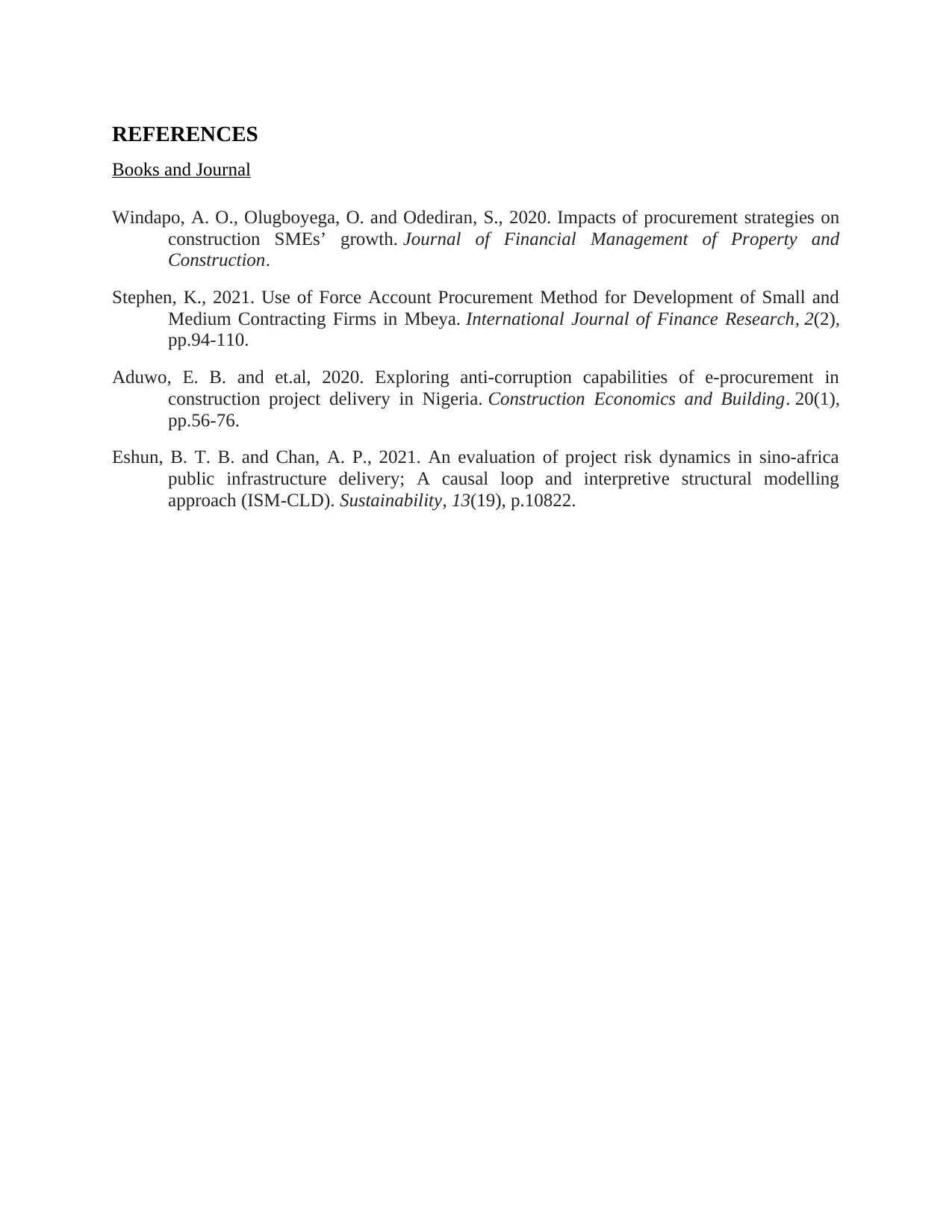
REFERENCES
Books and Journal
Windapo, A. O., Olugboyega, O. and Odediran, S., 2020. Impacts of procurement strategies on
construction SMEs’ growth. Journal of Financial Management of Property and
Construction.
Stephen, K., 2021. Use of Force Account Procurement Method for Development of Small and
Medium Contracting Firms in Mbeya. International Journal of Finance Research, 2(2),
pp.94-110.
Aduwo, E. B. and et.al, 2020. Exploring anti-corruption capabilities of e-procurement in
construction project delivery in Nigeria. Construction Economics and Building. 20(1),
pp.56-76.
Eshun, B. T. B. and Chan, A. P., 2021. An evaluation of project risk dynamics in sino-africa
public infrastructure delivery; A causal loop and interpretive structural modelling
approach (ISM-CLD). Sustainability, 13(19), p.10822.
Books and Journal
Windapo, A. O., Olugboyega, O. and Odediran, S., 2020. Impacts of procurement strategies on
construction SMEs’ growth. Journal of Financial Management of Property and
Construction.
Stephen, K., 2021. Use of Force Account Procurement Method for Development of Small and
Medium Contracting Firms in Mbeya. International Journal of Finance Research, 2(2),
pp.94-110.
Aduwo, E. B. and et.al, 2020. Exploring anti-corruption capabilities of e-procurement in
construction project delivery in Nigeria. Construction Economics and Building. 20(1),
pp.56-76.
Eshun, B. T. B. and Chan, A. P., 2021. An evaluation of project risk dynamics in sino-africa
public infrastructure delivery; A causal loop and interpretive structural modelling
approach (ISM-CLD). Sustainability, 13(19), p.10822.
⊘ This is a preview!⊘
Do you want full access?
Subscribe today to unlock all pages.

Trusted by 1+ million students worldwide
1 out of 9
Related Documents
Your All-in-One AI-Powered Toolkit for Academic Success.
+13062052269
info@desklib.com
Available 24*7 on WhatsApp / Email
![[object Object]](/_next/static/media/star-bottom.7253800d.svg)
Unlock your academic potential
Copyright © 2020–2025 A2Z Services. All Rights Reserved. Developed and managed by ZUCOL.




